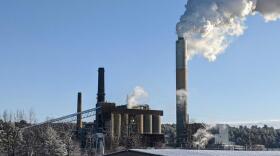Every autumn, Americans fall in love with pumpkins.
Last year, over 1.2 billion pumpkins were produced in the U.S. But as the air chills and our pumpkin-hysteria wanes, where do all these orange symbols of the season go?
All too often, the answer is landfills. Food (and yes, that includes pumpkins), make up about one fifth of all of the trash thrown away in the United States. And all that organic waste produces methane, a potent greenhouse gas that’s contributing to the climate crisis.
In New Haven, Connecticut, one school is working on a solution with a fun twist: a community compost drop-off, which once a year, gets its own unique brand of pumpkin spice – old discarded pumpkins.
“Instead of sending it off to contribute to those greenhouse gases, we're putting it into our soil here at the farm to nourish our community,” said Schandra Madha, the compost coordinator at Common Ground High School, Urban Farm and Environmental Education Center.
The public was recently invited to the school’s composting site to smash their old pumpkins.
Children and adults wielded hammers, and safety goggles, as they hacked and splattered their way through old jack-o-lanterns and pumpkins.
The end result? More than 580 pounds of pumpkin tossed into the school’s compost mix.
A community gathers
Elynn Natal, 16, is a student at Common Ground. As attendees began to trickle in for the event, Natal said learning to get rid of waste sustainably is one reason she’s worked in the compost area for three years – it’s also centering.
“It's a lot of understanding yourself and the world around you, because it's at school, so much going on, you need something to ground you,” Natal said.
Attendees showed up with jack-o-lanterns and pumpkins of all shapes and sizes. Adults used sidewalk scrapers, shovels, and both ends of a hammer to break up the rotting gourds, and learned it takes a bit of effort.
“This is more exhausting than I thought!” said Liam Miller, as he took a brief break at hammering his now half-broken pumpkin.

Younger kids were given a small hammer. Nate and Quinn Robinson are 7 and 4 years old, and took turns knocking away at their jack-o-lantern. And their parents joined in too.
“It’s a chance to not be at home on this beautiful day and let them go to town on a pumpkin rather than wrestling,” Laura Snow-Robinson said. The family came last year, too.
Aside from composting, there are a number of other options for disposing of pumpkins: burying them, cooking them or donating them to farms to be used for animal feed.
After each group of people are done, everyone helps sweep and scoop the smattered innards into piles, which will be turned to compost on-site.
‘Nothing gets thrown away’
From afar, the active compost pile looks like a large mound of steaming dirt. It’s a mix of food waste from Peels on Wheels and the school’s cafeteria, along with community collection. Leaves and wood chips from local landscapers are part of the “recipe” too. And now, several hundred pounds of pumpkin.
Standing on top of the pile you can see, smell, and feel the hot compost at work. Looking at the large thermometers, Elynn Natal said the pile is around 160 degrees Farenheit in the back, and closer to 130 degrees in the front. That’s because of the decomposers producing heat when they eat.
“We say that our compost is driven by the F.B.I.,” Madha said, which stands for, "fungus, bacteria and insects, or people also say isopods.”

The nutrient-dense material helps the Common Ground students and staff grow 14,000 pounds of food every year.
The state has been trying out composting recently. Three years ago the Department of Energy and Environmental Protection piloted programs in 15 municipalities. New Haven wasn’t among them. Six of the towns have made the programs permanent, and the state is opening up grants again next year for the next round of pilots.
For Madha, composting is not just about managing waste like pumpkins or food scraps. Especially with many of the Common Ground students coming from food insecure situations, she said it’s healing to see things that would otherwise be thrown out, turned into a resource.
“Nothing gets thrown away,” Madha said. “There is no ‘away’ it’s always going to someone else that’s going to have to take care of it.”





